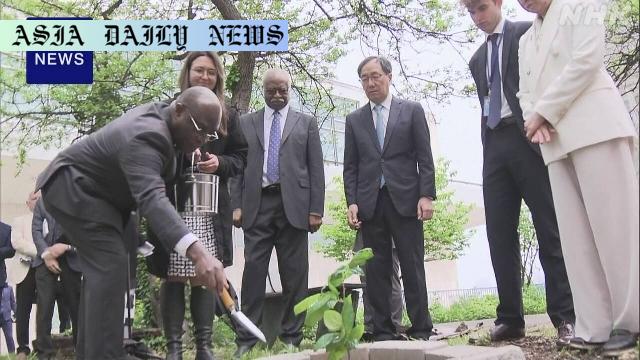Hiroshima seeds that survived atomic bombing planted at UN for a hopeful future, inspiring peace and disarmament.
- Hiroshima seeds that survived the atomic bomb were planted at UN HQ.
- The trees symbolize resilience and efforts towards nuclear disarmament.
- This year marks the 80th anniversary of the Hiroshima and Nagasaki bombings.
- Green Legacy Hiroshima emphasized hope and peace through greenery.

Introduction: Seeds of Resilience
The story of the Hiroshima atomic bombing is one deeply etched in the pages of world history, symbolizing destruction, pain, and loss. Amid this devastation, seeds from a persimmon tree near the hypocenter of the 1945 Hiroshima blast not only survived but thrived, defying all beliefs that life could exist in the aftermath of such unparalleled destruction. In a monumental ceremony, two saplings grown from these seeds have been planted at the United Nations headquarters in New York. Their presence carries a profound message of peace, resilience, and a nuclear-free world.
The Symbolism of the Persimmon Saplings
The planting event was a remarkable occasion that sought to emphasize unity and the shared desire for global peace. The persimmon seeds, exposed to an intense explosion and radiation just 500 meters from ground zero, embody resilience against nature’s harshest trials. Their ability to bear life, decades after the blast, represents hope and regeneration amidst despair. Furthermore, this year marking the 80th anniversary of the Hiroshima and Nagasaki bombings provides an appropriate backdrop for reinforcing the commitment to nuclear disarmament. These saplings serve as living reminders of the horrors of nuclear warfare and the enduring will to strive for global harmony.
A Commitment to Peace
Speakers at the ceremony, including Japan’s UN Ambassador Yamazaki Kazuyuki, the President of the UN General Assembly, and Under-Secretary-General Nakamitsu Izumi, delivered poignant remarks about the significance of these trees. Izumi underscored the importance of reversing today’s increasing global arms build-up, urging leaders to use this anniversary as a catalyst for renewed efforts toward international disarmament. Through the planting of these trees, the attendees aimed to create a legacy of peace, invoking a collective vision for a nuclear-free planet.
Lessons From History: Hope Amidst Tragedy
Shimazu Junko, a member of the Green Legacy Hiroshima initiative, recounted the hope and inspiration these trees provided to atomic bomb survivors, or hibakusha, in 1945. Contrary to fears that Hiroshima would remain barren for decades, the sight of budding greenery in the ruins inspired a belief in survival and renewal. Today, Junko and her team remain committed to sharing this legacy globally, spreading seeds that symbolize resilience and hope wherever they are planted. Their ultimate vision aims to transform Hiroshima’s tragic story into a global driver for peace.
A Call for Global Action
This symbolic gesture at the UN resonates far beyond New York. It underscores the ongoing global challenge posed by nuclear proliferation and the urgent need for unified efforts to address it. The saplings highlight the importance of respecting historical lessons to build a better future. As arms races escalate and international tensions rise, this story serves as a powerful reminder for leaders and communities to prioritize de-escalation, disarmament, and reconciliation.
Through this story of resilience, humanity is called to look beyond political boundaries, recognize shared values, and embrace a future marked by peace and sustainability. The saplings at the United Nations will grow alongside ongoing efforts and renewed partnerships, which the global community needs now more than ever.



Commentary
The Power of Symbolism in Addressing Global Challenges
The recent planting of Hiroshima saplings at the United Nations headquarters serves as a strong reminder of the symbolic power that can unite nations around shared goals. These saplings, representing resilience and hope, go beyond mere botany to deeply connect humanity with the lessons of history. Recalling the horrors of Hiroshima and Nagasaki, the story of the seeds turning into thriving trees carries an undeniable message: even in the face of devastating atrocities, life can be rebuilt with courage and determination.
Laying Foundations for a Nuclear-Free World
This initiative exemplifies the creative and poignant ways citizens and leaders can address global challenges. Nuclear disarmament has long been an elusive dream, hindered by political differences and defense strategies, but projects like these have the potential to create a unifying narrative. These symbolic trees at the UN draw much-needed attention to the pressing issue of nuclear arms while fostering pathways for collaboration among nations.
Engaging Generations Through Living History
Younger generations must engage with the legacy of Hiroshima and Nagasaki to understand the responsibilities they carry in shaping the future. The planting of the Hiroshima saplings provides a tactile and relatable way to learn about resilience and the dangers of nuclear arms. It serves as a bridge connecting historical events with present and future disarmament efforts, making the past’s lessons relevant today. Such initiatives must continue, ensuring hope and peace flourish, just as these saplings do in New York’s soil.